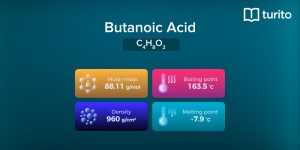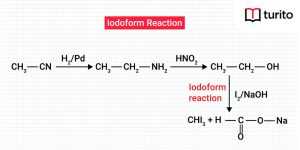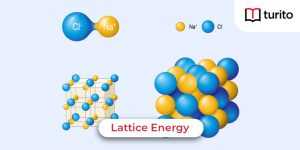Hydrazine
Hydrazine is an inorganic material that is also a simple hydride. The hydrazine formula is N2H4, and it is a colorless volatile liquid. It is very poisonous unless treated in a solution such as NH2NH2 xH2O. In 2015, the global hydrazine hydrate industry was valued at $350 million. Hydrazine is used mostly in manufacturing polymer foam as a cleaning agent. However, it is also a predecessor to polymerization catalysts, medicines, and agrochemicals, as well as a long-term rocket fuel that can be preserved and is mainly useful for spaceship propulsion in space.
This article describes what hydrazine is, the N2H4 compound name, its properties, and its uses.
What is Hydrazine?
Hydrazine is an inorganic substance having the chemical formula N2H4. Hence, the N2H4 compound name would be Hydrazine.
Hydrazine, known as diamine, dizane, or nitrogen hydride, completely dissociates in water and is a strong base. It is an azane, and it’s quite volatile. Each H2N-N subunit is pyramidal, and the NN bond length is about 1.45. The rotational resistance is twice as strong as that of ethane. These physical features are similar to gaseous hydrogen peroxide because it adopts an anticlinal configuration skewed in character and is bound to encounter a significant rotational barrier.
Diamine in its dehydrated state is a colorless, boiling oily liquid with an ammonia-like odor. It has a high boiling point of 99 degrees Fahrenheit. If traces of air are left during the distillation process, it bursts into flames. It is poisonous to cells and corrosive to them. When it is burned, it emits hazardous nitrogen oxides.
It is often used to make gas antecedents for airbags and is principally employed in rocket fuel of different types. Hydrogen is utilized as an oxygen absorber in both nuclear and traditional power stations to regulate the quantity of oxygen in the water and thereby reduce corrosion. Thus, hydrogen corresponds to a class of organic molecules formed when organic groups substitute one or more than one hydrogen atom with hydrogen.
Did you know:Short-term exposure to high amounts of hydrazine can cause eye irritation, nasal irritation, discomfort in the throat, dizziness, nausea, headache, pulmonary edema, and seizures. Acute exposure can even lead to damage to the liver, CNS, and kidneys in humans. A person can also get into a coma. |
Properties of Hydrazine
Hydrazine’s physical properties:
- Hydrazine has the molecular formula N2H4.
- Hydrazine’s molecular mass is 32 g/mol.
- The density of hydrazine is 1.02 g/cm3.
- Hydrazine has a similar smell to that of ammonia.
- Hydrazine is a transparent, greasy, bubbling liquid.
- Hydrazine has a critical temperature of 114° C.
- Hydrazine has a melting point of 2 degrees Celsius.
- The index of refraction is 1.46.
Hydrazine’s Chemical Characteristics
- Hydrazine reacts with acids and a few metallic salts to create chemicals used to produce particular explosives and fumigants.
- Hydrazine reacts with organic molecules to create alkyl hydrazines.
- Hydrazine burning in the presence of air creates N2 and H2 This is an exothermic reaction that releases heat. The reaction is as shown:
N2H4 + O2 → N2 + 2 H2O
- N2 and ammonium chloride are produced when hydrazine interacts with chloramine. The following is the reaction:
N2H4 + 2 NH2Cl → 2 NH4Cl + N2
Hydrazine Synthesis
The formation of an N-N single bond is the primary pathway among the several routes explored for synthesizing hydrazine. Hydrazine synthesis can be broadly divided into two different pathways. The first one uses chlorine as an oxidative agent, whereas the second pathway generates hydrazine through ammonia oxidation.
1. Ammonia Oxidation through Oxaziridines from Peroxide
The interaction of ammonia with hydrogen peroxide with a ketone mediator produces hydrogen through the oxidation of ammonia. The peroxide process is another name for this process. The reaction is as follows:
2 NH3 + H2O2 → N2H4 + 2 H2O
This process begins with the fusion of ketone and ammonia, which is subsequently oxidized by hydrogen peroxide to yield oxaziridine. It is a three-membered ring composed of carbon, oxygen, and nitrogen. Hydrogen is created from oxaziridine by ammonia treatment. A single nitrogen bond is formed based on this procedure.
The generated azine is hydrolyzed to provide hydrazine and the reproduction of the ketone, methyl ethyl ketone.
ME(Et)CNNC(Et)ME + 2H2O → 2ME(Et)CO + N2H4
2. Oxidations Using Chlorine
The major product that occurs in synthesizing hydrazine is sodium hypochlorite, which is an active component in many bleaches and ammonia without the addition of any ketone accelerator. The procedure is known as the Olin Raschig process, originally used in 1907. This approach is based on the reaction of monochloramine with ammonia, which results in forming an N-N single bond with HCl as a residue. The following is the reaction:
NH2Cl + NH3 → H2NNH2 + HCl
Urea can be oxidized in lieu of ammonia in the preceding method. In the instance of urea, sodium hypochlorite also acts as an antioxidant. The next reaction is as follows.
(H2N)2CO + NaOCl + 2NaOH → H2NNH2 + NaCl + H2O + Na2CO3.
Hydrazine Applications
The following are some of the applications for hydrazine:
1. A Pesticide and Medicinal Precursor
Hydrogen serves as a precursor for several medications and insecticides. Hydrazine is frequently converted into aromatic rings such as pyrazoles and pyridazine. A few examples of commercially bioactive hydrogen derivatives are:
- Hydrazine sulfate
- Triadimefon
- Rizatriptan
- Fluconazole
- Cefazolin
- Anastrozole
- Metazachlor
- Paclobutrazol
- Propiconazole
- Metribuzin
- Dibenzoylhydrazine
- Metamitron,
- Diclobutrazole
2. Gas Producers and Propellants
Hydrazine is primarily utilized as a dispersing agent in gas generators and propulsion systems. Azodicarbonamide, for example, yields 100-200 mL of gas for every gram of precursor. When hydrazine interacts with sodium nitrite, a gas is formed that is used as a reactant in airbags. Hydrazine is also utilized as a reusable shelf-stable propellant aboard spacecraft, such as the Dawn mission to Ceres and Vesta, as well as to lower the amount of oxygen and adjust the pH of water utilized in huge industrial furnaces. Hydrazine is used to drive the backup power units of the F-16 fighter jet and U-2 stealth bomber.
3. As Rocket Fuel
During World War II, it was employed as a constituent of rocket fuel. It is also a prelude to medicines, herbicides, and pesticides and a long-term propellant that can be stored and is mainly useful for spaceship propulsion in orbit. Hydrazine is still used in some armored trucks nowadays, although it is largely used in interstellar research. The Curiosity Rover, on Mars since 2012, landed on the planet using hydrazine. In 2016, the NASA New Frontiers project ‘Juno’ achieved an astonishing entry into Jupiter’s orbit using hydrazine and dinitrogen tetroxide.
4. Organic Syntheses’ Precursor
N2H4 is beneficial due to two key characteristics. For starters, it’s a powerful reducing agent, with water and nitrogen as the sole residues. Therefore, it converts plutonium oxides in nuclear material back to Pu metals. It is injected into power plant water-cooling systems to keep the pipes from corroding/oxidizing. This is accomplished by collecting dissolved oxygen that would otherwise corrode the metal.
N2H4 + O2 → N2 + 2H2O
It is also used as a precursor in several organic syntheses and as fuel cells, polymerization catalysts, soldering fluxes, and picture developing fluid. It’s also utilized to create some of the precursors needed in the polymerization reaction that results in spandex (Lycra) fibers, which athletes, singers, and superheroes ought to be thankful for.
Conclusion
Hydrazine is a chemical compound having the formula N2H4. It comprises two singularly bonded nitrogen atoms and four peripherally bonded hydrogen atoms. It is a colorless, poisonous irritant and sensitizer in its dehydrated state, causing central nervous system impairment and effects as severe as tumors and convulsions. The unpleasant odor of hydrazine is similar to that of ammonia, and it is a very reactive reducing agent.
Frequently Asked Questions
Q1. What is hydrazine’s oxidation state for nitrogen?
In hydrazine, nitrogen has an oxidation state of -2, whereas hydrogen has an oxidation state of +1. Utilizing the molecular formula N2H4, you can easily compute the oxidation potential of nitrogen in hydrazine. There are four hydrogen ions, and H can have a +1 oxidation state. Assume that the oxidation state of n is equivalent to x.
2N + 1H = 0
2x + 4 = 0
2x = -4
x = -2
As a result, the oxidation state of nitrogen in hydrazine is -2.
Q2. What is the purpose of hydrazine as rocket fuel?
The N2H4 compound is hydrazine, an ammonia compound with two N atoms and four H atoms. Comparatively, ammonia has a single nitrogen atom and three hydrogen atoms. It can be utilized in jet engines and other applications. Hydrazine (N2H4) is an antioxidant. It’s extremely poisonous and unstable. Hydrazine is a rocket fuel because it reacts exothermically with oxygen to form nitrogen gas and water fumes. The heat released and the increased number of gas moles provide a driving force. The combustion of hydrazine produces an exothermic reaction.
Q3. What is the cause of Hydrazine’s instability?
Hydrazine is a very hazardous and potentially unstable compound that resembles smelling salts, presumably because it is generated utilizing two alkali atoms that are bonded together. The formula is N2H4, and its composition is similar to the hydrogen peroxide symmetry.

Relevant Articles
Butanoic Acid – Structure, Properties, Uses
Butanoic Acid The carboxylic acid, butanoic acid, has the structural …
Butanoic Acid – Structure, Properties, Uses Read More »
Read More >>What is Iodoform? Characteristics and Uses
Iodoform The formula for Iodoform is CHI3. It is biotic …
What is Iodoform? Characteristics and Uses Read More »
Read More >>Lattice Energy – Explanation, Factors & Formulas
Lattice Energy Lattice energy evaluates the intensity of the ionic …
Lattice Energy – Explanation, Factors & Formulas Read More »
Read More >>Lead Acetate – Definition, Properties, Uses
Lead Acetate Have you ever licked lipstick when you sketch …
Lead Acetate – Definition, Properties, Uses Read More »
Read More >>Blogs
Is 34 a Good ACT Score? How Can I Improve It?
Let’s look at the average ACT score you’ll need for a great application and how you may improve it.
How Much Do AP Tests Cost? Everything You Need to Know
Students may be eligible for both types of rewards based on their AP exam scores and the college’s policies.
Best Online Coding Classes For Kids
Coding has become a vital piece of a kid’s education and a wonderful opportunity for them to display their creativity and ingenuity.
















Comments: